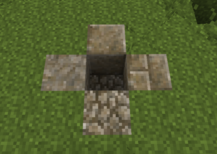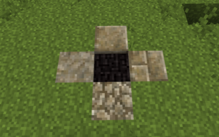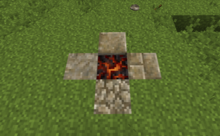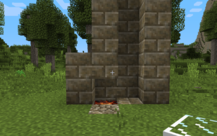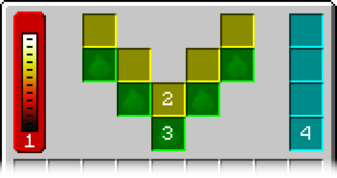Forge
Forges are the TFC replacement for the Vanilla furnace. They are the primary way of melting Metals in TFC.
Obtaining
Forges are created by making a 1x1 hole that is surrounded by any combination of cobblestone, bricks, stone, or smooth stone on all four sides and underneath. Seven pieces of charcoal are then placed with ![]() Right Click in the hole, and lit with a firestarter or a flint & steel.
Right Click in the hole, and lit with a firestarter or a flint & steel.
Once the forge has been lit it will quickly burn out unless more fuel is added. In order to relight the forge, at least one piece of fuel must be placed in the fuel slots, and a firestarter or flint & steel must be used to ![]() Right Click on the forge block.
Right Click on the forge block.
Chimney
Forges must have proper ventilation in order to work. Forges can be exposed directly to the sky for ventilation, but will stop working during rain or snow. Alternatively, a chimney structure can be used to protect the forge from precipitation, while allowing it to still be properly ventilated. The following image is an example of where the air blocks must be in valid chimney structures; while the pictured chimney column is adjacent to the forge, it is also possible to position the chimney column one block further away. Note that the chimney cannot go diagonally from the forge block. Additionally, the vertical portion of the chimney's air blocks must have direct access to the sky. The bellows, crucible or any other non-opaque block can take place of the air blocks in the chimney.
Usage
Forges are used to heat up metals for melting, make torches, and cook sand to make glass, and cook food (albeit poorly). Forges also provide a heat source for crucibles.
GUI
Note: If the player is unable to access the GUI after the forge has been created, it is likely that the forge does not have a valid chimney.
Heating Items
Forges will gradually heat items in the heating slots as long as it is burning fuel. Items that reach their melting temperature will grab an empty ceramic mold from the storage slots and attempt to place the unshaped ingots in the storage slots. If there is no room in the storage slots, the unshaped ingots will be spit out into the world. If there are no ceramic ingot molds in the storage slots, the melting metal will be destroyed. Ceramic vessels can also store up to 4000 units of molten metal. Anything that can be made using a pit kiln or firepit can be made in a Forge. While it is possible to cook food on a forge, the resulting cooked food will decay more quickly than food cooked in a firepit or on a grill; also, bread, though not other foods, will burn up and be destroyed if it gets too hot.
Fuel
Items in a forge can only get as hot as the current burning temperature of the fuel. A bellows can be used to increase the current burning temperature at the fuel, and heat the forge twice as fast at the expense of consuming the fuel twice as fast. Note: Bellows only affects how quickly the forge itself heats up. Items heating up inside of the the forge will heat up at the same rate regardless of if a bellows is used or not.
When the forge runs out of fuel, the items in the heating slots will start to cool down, and the forge will eventually turn off.
| Legend: | Without Bellows | With Bellows |
|---|
| Fuel | Yellow White | White | Brilliant White | ||||||||||||
|---|---|---|---|---|---|---|---|---|---|---|---|---|---|---|---|
| . | : | :. | :: | . | : | :. | :: | ||||||||
| Coal |
|||||||||||||||
| Charcoal |
|||||||||||||||
